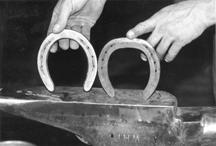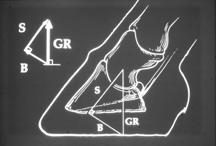| Published in the May 2000 Issue of Anvil Magazine
In spite of the sensationalism of its title, the Extreme Breakover Roundtable
began in a relatively subdued fashion. Dr. Stephen O'Grady, DVM, moderator,
defined a few general terms to a packed room using some interesting diagrams,
elaborating on them only briefly so as to speed the lecture towards its ultimate
goal: a question-and-answer session between the audience and roundtable on
the much-disputed topic of breakover. The term point of breakover was defined,
per the new glossary recently approved by the A.A.E.P. as "the most dorsal
contact of the ground surface of the foot in the unshod horse, or the shoe
in the shod horse, with the ground, the moment the heels begin to rise off
the ground."
The significance of shear force was noted, meaning that when the breakover is moved back, the angle of the forces created by the weight and momentum of the horse in motion will tend to become less open (see diagram 1), so that the lines of force are better aligned with the bony column of P3, P2, P1. Using x-rays and diagrams, Dr. O'Grady illustrated clearly the necessity of learning to see inside the hoof capsule. The difference in bony alignment became quite obvious when looking at comparative x-rays with variations in the trim of the hoof that moved the breakover back. Add to this the dimension of variations in breakover created by shoes with different kinds of toes, and the impact of the fact that farriery is an art that requires a certain understanding of science really hits home.
Learning to visualize the lines of force clearly demonstrates that moving the breakover back tends to move the navicular bone proximally. Yet, too much breakover decreases the ground surface, making the foot unstable. Gradually, the main issue of discussion began to come to the fore. What actually is the definition of extreme breakover? As questions from the crowded floor were taken, it became clear that the farriers in the audience were intent on some answers. The first question directly addressed the inflammatory title of the roundtable. A farrier from the floor asked the board, "What do you consider "extreme breakover?" Now, it goes without saying that the roundtable format is a discussion and, hence, a setup for getting many different answers. Consequently, two very different, but related responses were given. Emil Carre, CJF, an experienced farrier and president of the American Farriers Association, responded by defining "extreme breakover" as: disengaging the flexor tendon prematurely and engaging the extensor tendon too soon. Bob Pethick, CJF, another farrier on the roundtable, responded by saying that, preferably, you want to have 2/3 of the foot behind the widest part of the hoof (palmar aspect) and 1/3 in front. Emil Carre stepped in again to interject, with unfortunate accuracy, that often we shoe the hoof capsule, without consideration of the internal structures. The second farrier's voice from the floor brought up a fairly new concept, namely that we need to learn to read where the coffin bone is from the bottom of the foot. Dr. O'Grady was quick to clarify that the only true way to identify the position of the coffin bone is with radiographs. Although it was not brought up in the discussion, there is at least some evidence, based on the research of Gene Ovnicek, CJF, that there are some common landmarks that can be read from the bottom of the hoof. These common landmarks, when assessed relative to each other, tend to indicate fairly well where the coffin bone lies within the hoof capsule. A series of trial-and-error attempts to isolate these landmarks has been corroborated by x-rays afterwards to verify the exact location of the coffin bone within. If a representative study were large enough, it would be relatively easy to prove or disprove the accuracy of the landmarks by simply verifying the location of the coffin bone using x-rays. Another question from the floor was in regard to the issue of pathologies. A farrier specializing in lameness prompted the roundtable to discuss whether or not there might be certain situations, such as in the case of laminitis, where it would be imperative to release pressure on the flexor tendons by moving the point of breakover back to a place that would otherwise seem excessive. Bob Pethick concurred that it is imperative to distinguish between the treatment of a sound foot and a pathological one. He affirmed that there are situations - such as in the case of laminitis - when extreme breakover (i.e., further back than would be considered appropriate on a horse with a healthy hoof conformation), is not extreme at all, but is actually indicated for that specific pathology - at least temporarily. Dan Haussman, CJF, who quite artfully trimmed feet and shaped shoes for the demonstration the morning before the roundtable, interjected that it is important to think in terms of shoeing for a month from now, not just for today. The more out of balance a foot grows, the more it distorts. Bob Pethick concurred, and added that taking the sole depth down usually makes for a heel-first landing, which is a healthier way for the foot to hit the ground. Derek Poupart, CJF, a farrier from South Africa, added that it is important to learn to think about the heel in relation to the toe; for example, think about what causes underrun heels in the first place. At this point, Emil Carre jumped in to emphasize that breakover and caudal support both influence hoof capsule distortion and that sometimes orthopedic measures such as wedge pads are indicated, rather than focusing solely on the toe. It gradually became clear that focusing solely on the toe, without considering the rest of the hoof in relation to it, can lead to completely misconstruing the information about where the point of breakover should be. Since each and every foot is different, often with significant differences in the feet of the same horse, each hoof must be considered individually, and in relation to the horse's other hooves. At first encounter, it is easy to oversimplify the concept of moving the breakover back by thinking it means to rasp off the toe, without regard to the relationship between the toe, the heel and the proportions of the plantar aspect of the hoof. Perhaps this explains why sometimes one hears about horses getting sore after having the breakover moved back: it may inadvertently have been done without understanding all the principles involved. As a group, the roundtable members all agreed that, when in doubt, use a radiograph to verify what is going on and learn from the mistakes of others. Dean Pearson, CJF, suggested riding with an experienced farrier who has already learned to apply the principles of how to move the breakover back successfully, rather than taking a chance on hurting a horse by misapplication of half-understood concepts. In summary, it would seem that extreme breakover is not extreme at all, but merely somewhat radical in terms of how it looks to the eye untrained in visualizing the three- dimensional internal dynamics of the hoof capsule. But then that's the meat and potatoes of horseshoeing: promoting the long-term health of the foot and the joints above it, not shoeing for appearance. It's what makes the difference between `hack `em and tack `em,' and a farrier who has grown to appreciate and to practice the true craft of the trade.
Return to the May 2000 Table of Contents
|

